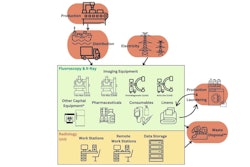AI yields much promise in medical imaging, but radiology leaders should be cognizant of the technology’s environmental impact, according to a paper published February 27 in Radiology.
A team led by Florence Doo, MD, from the University of Maryland in Baltimore outlined strategies on how radiologists can better practice sustainability when implementing AI into their clinical workflows.
“Radiology departments should be aware of the energy required to train and deploy AI models in order to balance the associated greenhouse gas emissions with the potential for AI to improve environmental sustainability in radiology,” Kate Hanneman, MD, from University Health Network in Toronto, Ontario, Canada, told AuntMinnie.com.
The World Health Organization (WHO) states that climate change is the largest health threat to humanity. With this in mind, medical imaging should manage greenhouse gas emissions while addressing health effects related to climate change.
Doo and colleagues noted that data centers and computational efforts are significant contributors to emissions in radiology. They wrote that this is due to increases in big data and AI applications that have led to large energy requirements for developing and deploying AI models.
However, the researchers also acknowledged that AI could improve environmental sustainability in medical imaging. This includes shortening MRI scan times with faster acquisition times, improving the scheduling efficiency of scanners, and optimizing the use of decision-support tools to reduce low-value imaging.
Doo et al discussed strategies on how radiologists can promote sustainable practices when using AI.
AI development and deployment
The researchers outlined actions that could be taken in the stages when AI applications are being developed and deployed in clinics.
These include using energy-efficient configurations, such as low-power CPU, to minimize energy use and modifying online general AI greenhouse gas calculators for radiology AI applications.
Also, the team called for transparent efficiency metrics and reporting standards to be developed for radiology AI models and strategies to promote multi-institution collaboration. For the latter, this includes centralized data sharing and federated learning models and requirements by journals for code and data sharing.
Data storage and energy choices
Facilities can also optimize data compression to minimize data storage requirements, as well as implement tiered storage systems based on frequency of access, the researchers wrote.
They also called for partnerships to be explored with cloud service providers who are committed to renewable energy sources and energy-conscious service scheduling.
Finally, the team suggested that AI models be trained in locations with renewable energy sources and low-carbon intensity grids and that data centers be in cooler climates to minimize the energy needed for cooling systems.
Imaging systems
AI can also streamline workloads and decrease energy use in imaging modalities, the researchers highlighted.
These include AI shortening MRI scan times and analyzing patterns between image acquisition and energy consumption. AI can also optimize energy efficiency by switching between system states with automatic system shutdowns during preexpected periods of idle time, the team wrote.
Other areas of opportunity include AI optimizing image contrast use, helping with opportunistic screening, personalizing recommendation guidelines, and reducing travel-related emissions with scheduling and no-show prediction modeling.
Hanneman said that radiologists can engage with policymakers and regulators to define metrics and set benchmarks for radiology AI emissions, as well as ensure equitable access to AI tools to improve sustainability. She added that team members are working on research to estimate the energy and greenhouse gas emissions associated with radiology AI models.
“Other groups are working on measuring and reducing the energy associated with data storage in radiology AI and implementing AI tools to reduce energy waste in scanner idle states,” Hanneman told AuntMinnie.com.
The full study can be found here.



















